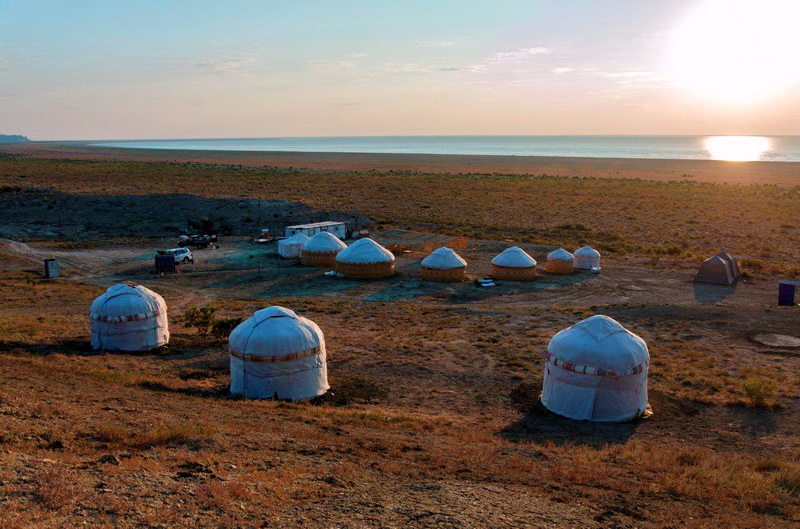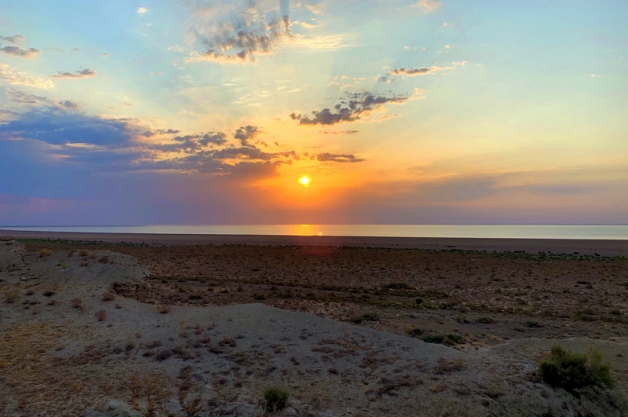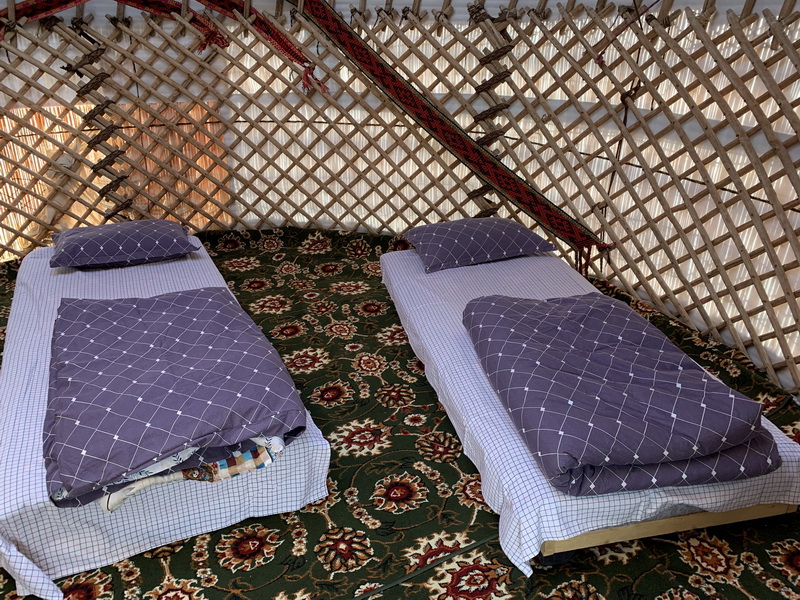Uzbekistan Deserts
The desert is one of the symbols of the Orient. It is vividly depicted in both fiction and movies. At first glance, it seems lifeless, but the deeper you move into it, the more amazing the world appears before you. The harsh temperament of Central Asian deserts makes people value those resources that seem familiar to most of us in everyday life, and their minimalistic image enhances the colorful beauty of the border towns.
The deserts of Uzbekistan cover almost half of the country's territory in the northwest. Uniting the ability to show the power of the Uzbek sun and heat, they are still radically different from each other. If the Kyzylkum desert with its purple barchans seems to have always challenged people to conquer its natural essence and win a place for graceful oases, the Aralkum desert appeared as a result of human activity and the blue smooth surface of the Aral Sea was replaced by sparkling white salt sand.
Across miles of vast land, you can hardly meet a human being. Only when you reach the banks of the Amu Darya River and rare oases can you find small settlements. Towns formed on the edge of the desert have played an important political, strategic, and commercial role throughout the history of Uzbekistan.
Red Desert of Kyzylkum
Area: 300,000 sq. km. Kyzylkum Desert is located between the Amu Darya and Syr Darya Rivers extending to the Aral Sea, and reaching the Tien Shan offsets to the northeast. The name comes from the words kyzyl ("red") and kum ("sand").
The major part represents a sand massif with dunes' height from 3 to 30 m. Stony and rocky geologic materials of the mountain ranges are also widespread. "Classic attributes" of the desert, such as takyrs and sandstones, are presented here widely as well.
All the peculiarities of sharply continental climate - hot day and cold night - are vividly felt here. It is said that after spending an hour in a desert in summer, your idea of what the heat is will change forever. By feeling the hot dry wind, you will start associating wind not only with refreshing coolness but also with fiery heat. This becomes especially vivid in the contrast with a rapid drop in temperature at night. Hence, when having a tour of Uzbekistan's deserts, we strongly recommend taking with you not only sun protection clothes but also some warm clothes.
In winter and spring, precipitation is rare. Accumulations of groundwater scattered over the desert contribute to the preservation of livestock breeding. The most cultivated species is the "ship of the desert" - the camel. Sheep breeding also occupies its niche, more focused on caracul breeding for the production of valuable fur.
The natural world of the Kyzylkum desert is rich in "indigenous inhabitants" such as turtles, lizards, varans, wolves, Jeyran (Gazella subgutturosa subgutturosa), steppe cats, jerboas, tolai hares, and gophers which are adapted to live in its unfavorable conditions. The most dangerous representative of snakes, the poisonous viper, also lives here. The birds of Kyzylkum are owls and larks, steppe eagles, bustards, and jays.
The Kyzylkum's flora is decorated with such plants and shrubs as black and white saxaul, sand sedge, and wormwood. But the scenery changes in spring, especially when wild tulips bloom.
The outskirts of Kyzylkum are currently undergoing a process of development through reclamation. Minerals and natural resources such as gold, gas, and uranium are being developed and extracted.
The mysterious world of the desert attracts tourists seeking to gain new impressions and experiences, and test themselves. However, the modern tourist industry offers quite comfortable conditions of stay for unprepared travelers, which are yurt camps. They permeate the atmosphere of nomadic life and give the effect of complete immersion in it. At the same time, yurt camps are equipped with basic amenities for sleep and hygiene. Camel milk tastings, horse and camel safaris, and dinners by the fire under the starry sky will add authentic color to your memories of travel in Uzbekistan.
Alatsky District of Bukhara Region has a recreation and retreat center built based on the Natural Salt and Sand Processing Center, which offers unique treatments using these natural substances. The exotic gastronomy admirers can taste unique snake soup here.
New Desert of Aralkum
Area: 38,000 sq. km. While drying, the Aral Sea leaves a salt desert on the shore, which explains its name - "Aral" and "kum" means "the sands of the Aral." Its second name "Akkum" is also congenial. "Ak" means "white." "White desert" began to form here in the early '60s, and the pathogenic process continues to this day, still expanding its borders. Sandy solonchaks, coming out of the territory of Uzbekistan, reach Kazakhstan.
The new Aralkum desert is practically unsuitable for fauna. The flora is limited to a meager 300 varieties of grasses and shrubs. The streams of the Syr Darya and Amu Darya rivers brought here significant masses of salts, toxins, and pesticides by washing them out of the soil irrigated to grow agricultural products.
The environmental disaster of the Aral Sea has gone far beyond Central Asia. Frequent dust storms carry 100 million tons of dust, salts, and small toxic particles through the air over considerable distances, and the substances from here have even been found even in Norway.
Despite the objective natural conditions, as a consequence of which the Aral Sea has already repeatedly changed in size over the millennia, reducing as well, we cannot deny the detrimental effect that thoughtless human economic activity has had on its condition.
The growing global awareness of the problem and the development of modern technology give hope that the Aral Sea's ecological disaster will be eliminated, becoming one of the highest achievements of humanity in the 21st century. Unfortunately, for now, the Aralkum desert only serves as an admonition to people, and this lesson must be learned and never repeated. That is why thousands of tourists come to the whitewashed shores of the Aral Sea every year to feel and see for themselves the consequences of what happened. Despite evoking slight sadness, sunsets and sunrises here are unusually spectacular. To witness them, you do not need to travel at night - accommodation is available in yurts. Fans of extreme sports can "tickle the nerves" by going on a jeep safari across the white sands of Aralkum.

A peculiar but no less memorable impression creates the town of Muynak in the Republic of Karakalpakstan with its famous "Graveyard of Ships" - once a flourishing fishing industry and a wonderful port were found here.
The Ustyurt Plateau: a desert and the border between Europe and Asia
Area: 200,000 sq. km. It occupies a territory between the Caspian Sea and the Aral Sea in western Central Asia. The desert and the Ustyurt plateau of the same name are located on the territories of Uzbekistan, Turkmenistan, and Kazakhstan, between the Aral Sea and the Amu Darya delta in the east, the Kara-Bogaz-Gol bay and lagoon, and the Mangyshlak Peninsula in the west. A group of bitter-saline lakes is found in the north.
The soil type is clay-stony and clay-solonchak with sandy areas of Sam desert in the northwest. Its eastern hard-to-reach escarpment, a cliff facing the Aral Sea, reaches 190 m in height. It is called chink and represents a recognizable trait specific to this area.
The average annual temperatures here are the lowest relative to the entire region, and the winters are the most severe.
Oil deposits have been discovered in the southern part of the plateau, while gas deposits are in the northern part.
Jerboas, gerbils, and gophers are common representatives of the fauna on the plateau.
21 million years ago there was an ocean here. Scientists have established this fact due to the shell fragments found in the limestone. No vegetation can be found on the plain relief of the plateau, except for rare bushes of saltwort and wormwood, which together with splits of dehydrated soil and white rocks resemble an alien landscape.
The sense of mystery in this unusual natural place is intensified by the contemplation of geoglyphs represented by figured patterns in the form of arrows. Scientists still cannot give an unequivocal answer about the reasons for their origin. The mysterious find was accidentally discovered in 1986 by scientists of the Academy of Sciences of Uzbekistan, who decided to survey medieval architecture from the air.
The former island and now swampy Barsakelmes, located southwest of the Aral Sea, which name in Kazakh means "you will go - you will not return" also adds to the mystical spirit of the Ustyurt Plateau.










